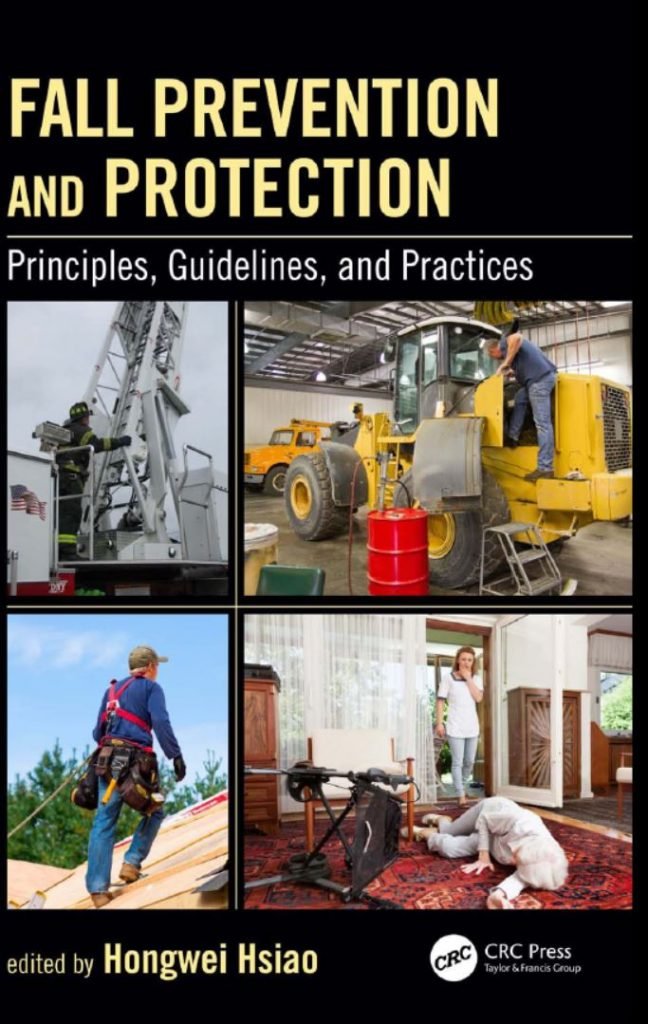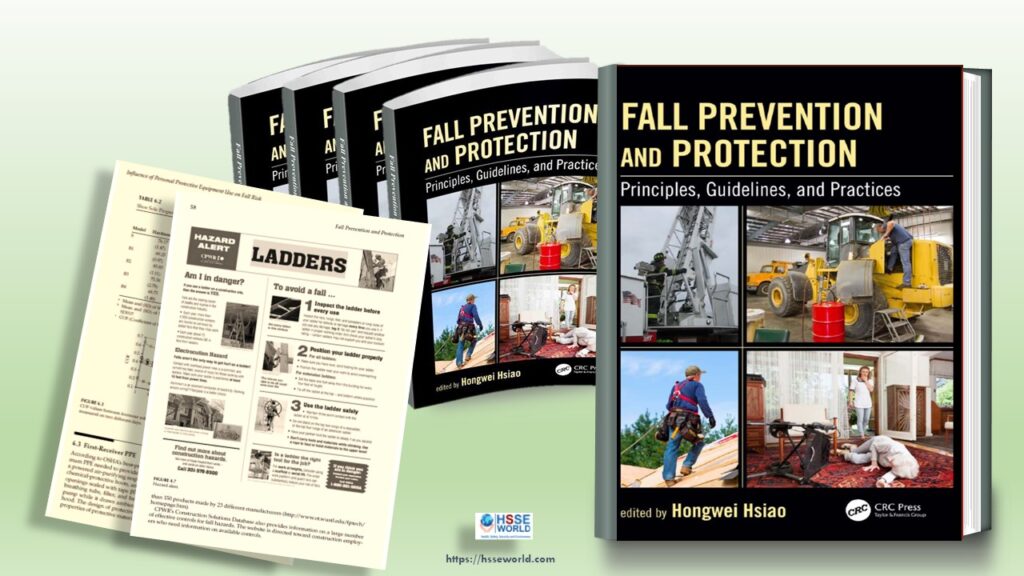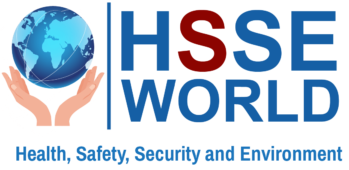E-Books: Fall Prevention and Protection Principles Guidelines and practices
5 min readFall Prevention and Protection Principles Guidelines and practices by Hongwei Hsiao. This book covers a wealth of knowledge from experts and informed stakeholders on the best ways to understand, prevent, and control fall-related risk exposures. Featured are subjects on (1) a public health view of fall problems and strategic goals; (2) the sciences behind human falls and injury risk; (3) research on slips, trips, and falls; (4) practical applications of prevention and protection tools and methods in industrial sectors and home/communities; (5) fall incident investigation and reconstruction; and (6) knowledge gaps, emerging issues, and recommendations for fall protection research and fall mitigation. The most recent report on fatal occupational injuries showed that there were 699 slip, trip, and fall (STF)-related fatalities in 2013 in the United States, which accounted for 16%of the overall occupational fatality cases. In addition, there were 296,140 STF-related nonfatal occupational injuries resulting in days away from work in 2013, which accounted for about 25.5% of all occupational injuries in that year. Many countries are facing the same challenges as the United States with STF injury problems in the workplace. Aside from workplace incidents, STFs were prevalent in U.S. homes and communities, resulting in 30,208 fatalities and 8.8 million injuries in 2013. Elderly individuals were, particularly at risk. More than 3.4 million nonfatal fall injuries among older adults (55 – 85+ years old) were recorded in emergency departments in 2013. Often, residents fall from ladders or on stairs, uneven surfaces, or wet areas at home. Similar concerns are also seen worldwide. The etiology of STFs as injury-producing events is multifactorial and encompasses multiple mechanisms of exposure. Working at height presents different fall risks than those found on work surfaces and floors. The different exposures represent serious safety risks in both cases and can result in fatal and serious nonfatal injuries. To address the various causes of multifactorial events such as these, there needs to be wide-ranging and multidisciplinary injury-mitigation research and translational efforts to provide safety professionals, workers, citizens, and caregivers with validated research findings, methods, and recommendations for safe practices.

This book covers a wealth of knowledge from experts and informed stakeholders on the best ways to understand, prevent, and control fall-related risk exposures. Featured are subjects on (1) a public health view of fall problems and strategic goals; (2) the sciences behind human falls and injury risk; (3) research on STFs; (4) practical applications of prevention
and protection tools and methods in industrial sectors and homes/communities; (5) fall incident investigation and reconstruction; and (6) knowledge gaps, emerging issues, and recommendations for fall protection research and fall mitigation.

Chapters in the book also address topics including (1) injury and fatality data, vulnerable groups fall among aging workforces, and global strategic goals for fall prevention and protection; (2) human balance control, vision, lighting, behavior, physics, environments, and tribology; (3) roofing, ladder use, scaffolding, aerial platforms, and fall arrest and rescue; (4) risk recognition, hazard control, training, and practitioners’ manuals; (5) fall
prevention applications in construction, health service, wholesale and retail trade, public safety, manufacturing sectors, and homes and community settings; (6) fall forensics, investigation methods, and case examples; and (7) knowledge gaps and emerging issues in protective technologies, vulnerable populations, fall prevention management, and effective implementation evaluation.
Contents
The Contents of Fall Prevention and Protection Principles Guidelines and practices
- 1. Fall Prevention and Protection: A Public Health Matter.
- 2. The Epidemiology and Risk Factors for Falls among Older Adults
- 3. Fall Prevention in Nursing Homes
- 4. Fall Risk Characteristics in the Construction Industry.
- 5. Vision Impairment and Fall Risk in the Elderly
- 6. Influence of Personal Protective Equipment Use on Fall Risk.
- 7. Suspension Tolerance Time and Risk after a Fall
- 8. Suspension Trauma and Fall-Arrest Harness Design
- 9. Fall Risk Associated with Restricted and Elevated Support Surfaces
- 10. Role of Support Surfaces in Preventing Slip, Trip, and Fall Injuries
- 11. Hazard Concept and Falls.
- 12. Friction Measurement: Methods and Applications
- 13. Stairway Safety Research
- 14. Improving Balance Control: Current State and Practices.
- 15. Ladder Safety: Research, Control, and Practice
- 16. Aerial Lift Safety Research and Practice
- 17. Falls from Commercial Vehicles: Safety Research, Control, and Practice
- 18. Fall Rescue: Training and Practice
- 19. Slip and Fall Controls for Pedestrian and Community Safety
Download the book
Fall Prevention and Protection Principles Guidelines and practices
More Downloads
- E-Books: Healthcare Hazard Control & Safety Management
- E-Books: Safety, Health and Working Conditions Training Manual
- E-Books: Energy Efficiency in Water and Wastewater Facilities
- E-Books: Fire Service Features of Buildings and Fire Protection Systems
- E-Books: Evaluation of Fire Safety free download
- E-Books: PPE for Chemical, Biological, and Radiological Hazards free
- E-Books: Changing the Workplace Safety Culture free download
- E-Books: Site Emergency Planning Workbook
- E-Books: Load Restraint Guide
- E-Books: Essential Practices for Creating, Strengthening, and Sustaining Process Safety Culture
- E-Books: System Safety Engineering and Risk Assessment
- E-Books: Permit-Required Confined Spaces
- E-Books: Is it Safe to Enter Confined Space?
- E-Books: 5-Minute Workplace Safety Talks
- E-Books: Safety Culture and High-Risk Environments
- E-Books: Practical Guide to Industrial Safety
- E-Books: Slip, Trip, and Fall Prevention for Healthcare Workers
- E-Books: Health and Safety at Work Key Terms
- E-Books: Fundamentals of Process Safety Engineering
- E-Books: Gas Detection Hand Book
- E-Books: Occupational health and safety management systems ANSI-AIHA-z10-2012
- E-Books: Hot Work on Drums and Tanks
- E-Books: Human Fatigue Risk Management
- E-Books: Guidelines for the provision of facilities and general safety in the construction industry
- E-Books: Handbook of Training in Mine Rescue and Recovery Operations ( 2021)
- E-Books: Code of Practice for the Safe Use of Lifting Equipment – Edition 9 (Nov 2019)
- E-Books: Free Forklift Health and Safety Best Practices Guideline
- E-Books: Handbook of Hazardous Chemical Properties
- E-Books: Human Performance Improvement through Human Error Prevention
- E-Books: Principles Of Fire Risk Assessment In Buildings
- E-Books: Investigation of Occupational Accidents and Diseases
- E-Books: Radiation Protection and Safety in Industrial Radiography
- E-Books: Basic Guide to System Safety, Third Edition
- E-Books: Food Safety Management-A Practical Guide for the Food Industry
- E-Books: Safety identification: Escape and evacuation plan signs- ISO 23601
- E-Books: Safety at Work
- E-Books: The Safety-Critical Systems Handbook 4th edition
- E-Books: Fundamental principles of occupational health and safety
- E-Books: Fire Safety Risk assessment Guide – Sleeping Accommodation
- E-Books: Mental health at work series
- E-Books: Live Fire Training: Principles and Practice
- E-Books: Pre-Startup Safety Review Guide
- E-Books: Fire and Emergency Drill Manual and Building Inspection Guide
- E-Books: Health and Safety: Risk Management 5th edition
- E-Books: Fire Protection systems -Third edition 2021
- E-Books: Fire Safety Logbook templates
- E-Books: From Accidents to Zero
- E-Books: Electric Safety Practice and Standards
- Your steps to chemical safety
- E-Books: Ergonomics and Psychology Developments in Theory and Practice
- E-Books: HAZOPS Should BE fun-The Stream-Based HAZOP
- E-Books: Safety Health and Environmental Auditing
- E-Books: A Quick Guide to Health and Safety
- E-Books: Occupational Ergonomics A Practical Approach
- E-Books: Job Hazard Analysis A Guide for Voluntary Compliance and Beyond
- E-Books: Electrical Safety of Low Voltage Systems




1 thought on “E-Books: Fall Prevention and Protection Principles Guidelines and practices”